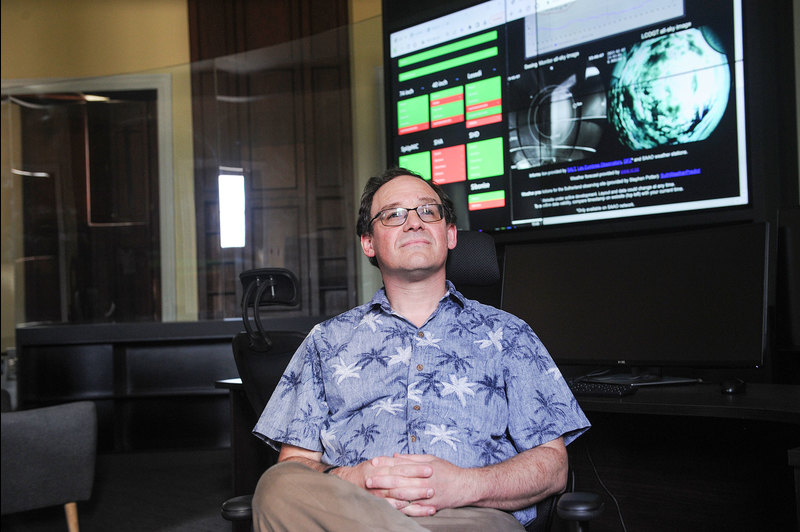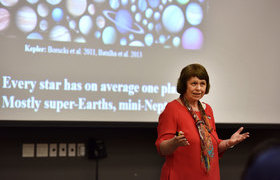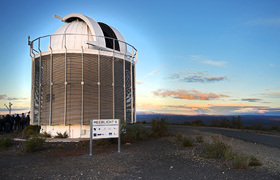Paying forward the ‘wow factor’ of stargazing
25 July 2023 | Story Di Caelers. Photo Lerato Maduna. Read time 6 min.
Since the age of about five, when he and his father built a telescope at home in the United States, the “wow factor” of the celestial universe has captivated Professor Daniel “DJ” Pisano. Now, as the University of Cape Town’s (UCT) new Department of Science and Innovation/National Research Foundation (DSI/NRF) South African Research Chair Initiative’s (SARChI) Chair in Extragalactic Multi-wavelength Astronomy, he is passionate about paying forward his skills, expertise – and his international contacts – to support the journeys of future stargazers.
Professor Pisano’s impressive resume has taken him to countries like Puerto Rico, Australia, the Netherlands, India and, of course, South Africa. He has taken leave from West Virginia University, where he is a professor in the Physics and Astronomy Department, with an adjunct appointment at the Green Bank Observatory, also in West Virginia, to be based at UCT.
Pisano admits to some trepidation at stepping into the not insubstantial shoes of his predecessors, professors Renée Kraan-Korteweg and Claude Carignan. But this graduate of Yale (Bachelor of Science) and the University of Wisconsin-Madison (PhD), certainly isn’t coming in cold.
Serendipity written in the stars
South Africa wasn’t on his radar growing up, but he was a postdoctoral research fellow in Australia when Sydney hosted the 25th International Astronomical Union (IAU) General Assembly in 2003. “The Australians were vying to host the Square Kilometre Array (SKA) Telescope when suddenly the South Africans showed up … and certainly caught several people off guard,” he recalled.
A year later he met Professor Kraan-Korteweg while she was on sabbatical in Australia. In 2007, good friend Professor Erwin de Blok took up one of the first SARChI Chairs at UCT, in radio astronomy, and two years later Pisano visited for the first time.
“I was blown away by the impressive commitment from South Africans to go after the SKA telescope.”
“I was blown away by the impressive commitment from South Africans to go after the SKA telescope and to build up its precursor, the MeerKAT radio telescope, which is just a phenomenal instrument. Wherever I went, South Africans knew all about it, with a familiarity I hadn’t previously experienced.
“It was really exciting to see the investment, development and especially the funding for the first students who were being supported by this programme.”
He knew he wanted to return. And after several visits for conferences and workshops, Pisano spent a sabbatical year at UCT in 2015/16, writing code and fine-tuning software that was applied to the COSMOS HI Large Extragalactic Survey (CHILES) – an acronym, he jokes, that he worked hard on, given that it was based in New Mexico. That 1 000-hour survey is a study of how the neutral atomic hydrogen (HI) content of galaxies evolves over the history of the universe. “After my sabbatical, and the extensive collaboration both educationally and research-wise the years leading up to this brought, my return seemed like fate.”
Building human capital
Pisano is determined to continue the legacy of Kraan-Korteweg and others, who have prioritised astronomy education for women and previously disadvantaged students in what is a traditionally male-dominated environment.
The whole point of these research chairs, he stressed, is to build human capital.
“Fundamentally, my goal is that when this Chair ends, if there were to be another five years, they wouldn’t rehire me.”
Pisano has nothing but praise for the calibre of his students’ preparation, enthusiasm and the scale of their active research and publications.
“The students are fantastic. From their second and third years, they’re already getting hands-on experience in a professional observatory. My goal is to use my international connections to broaden their already variable experience – thanks to their wonderful access to MeerKAT and other local resources – which certainly ensures they’ll be in demand anywhere they want to go,” he said.
River of hydrogen flowing through space
And what about his own affaire du coeur with the skies? Has it endured since his father got him out of bed to view his first night sky, the Andromeda galaxy, through that homemade telescope back when he was a child?
“Neutral atomic hydrogen is my jam!”
“Neutral atomic hydrogen is my jam!” he enthused.
In 2014, news reports described Pisano’s discovery of “what could be a never-before-seen river of hydrogen flowing through space”.
Asked to explain in layman’s terms, he said: “There is no star formation without neutral atomic gas, and although star formation is slower now than it was eight billion years ago when the universe was about half its current age, there is still lots of gas in galaxies.
“We know they must be getting that gas from their surroundings. And a lot of my career has been looking for that gas – looking for the ‘gas station’ that is refuelling them.”
This SARChI Chair offers Pisano the opportunity to “get back to the things I really like”: working closely with students and actively doing research.
“I’ve been an amateur far longer than a professional, and the ‘cool factor’ just never gets old. Now I’m here in the Southern Hemisphere where the sky is particularly stunning, with the centre of the Milky Way and the Magellanic Clouds.
“Even loadshedding makes me happy because you can just go outside, look skywards and see new things.”
 This work is licensed under a Creative Commons Attribution-NoDerivatives 4.0 International License.
This work is licensed under a Creative Commons Attribution-NoDerivatives 4.0 International License.
Please view the republishing articles page for more information.










